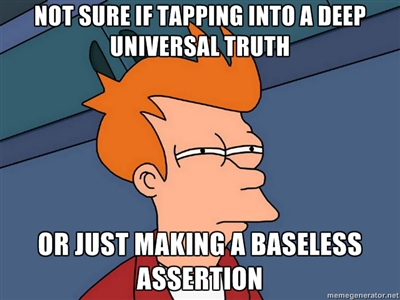
In the recent post about the importance of assertions in the unit tests I've mentioned that we should not test our code to prove what it's not doing and focus on testing what it is actually doing. Regarding that point of view I was asked whether I find it useful to use AssertWasNotCalled or similiar assertion methods provided by the mocking frameworks, as generally they are to ensure no work was done and an empty method is passing that kind of tests. This is an interesting question, let's analyze it.
I don't blindly believe in TDD and all its rules in every scenario, but let's stick to that context. As an example, let's write and test a Work method which is taking a boolean parameter to decide whether the actual work should be done.
[Test]
public void Should_do_no_work_when_false_given()
{
// arrange
var sut = new Service(workerFake);
// act
sut.Work(false);
// assert
workerFake.AssertWasNotCalled(x => x.DoWork());
}
I've discouraged testing what the code is not doing in the context of the third test-driven development rule, which says "you may not write more production code than is sufficient to pass the current failing test". According to that rule, for the test above, we may only end up with an empty method as an implementation - it will be just enough for the test to pass.
But earlier, there is the first rule of TDD - "You may not write production code until you have written a failing unit test". We've never saw the test failing.
Let's than approach the problem differently - starting from the "positive" path, where we can actually verify any outcome, instead of verifying the lack of it.
[Test]
public void Should_do_the_work_when_true_given()
{
// arrange
var sut = new Service(workerFake);
// act
sut.Work(true);
// assert
workerFake.AssertWasCalled(x => x.DoWork());
}
We can easily see this test failing for the empty Work method. Let's then implement it according to TDD rule number three (no single line of code not enforced by the tests).
public void Work(bool really)
{
worker.DoWork();
}
The test is now passing, rules are kept. We may now add back our "negative" test case - verifying no work is done when false is passed. This time the test will fail, rule number one is satisfied. We may now legally (according to the TDD) add the condition and finish our pretty sophisticated implementation:
public void Work(bool really)
{
if (really)
worker.DoWork();
}
The conclusion from this oversimplified example is that the AssertWasNotCalled test alone probably makes a little sense. But when considered as a part of the larger test suite for the method, and when implemented in correct order (outcomes verified first, lack of outcome last), it may even be the only TDD-compliant way of testing the intended behaviour.
The same rule applies to the validation method example I've mentioned in the previous post. Even if I'm against the unit tests that just expect no exception being thrown, if throwing an exception when needed is the method's single responsibility, there's no other way to test the "positive" (not throwing) behaviour in the unit tests other than verifying no exception was thrown.
As a side note - AssertWasNotCalled assertion method can actually be rewritten (in Rhino Mocks syntax) into:
workerFake.Stub(x => x.DoWork()).Throws(new Exception());
And when the production code actually calls the method it should not, the exception is thrown and the test fails. So the distinction between the test I consider assertionless and the valid one can be a bit blurry. But my personal opinion I'll stick with is to always have the assertions as explicit as possible, even if this is just a syntactic sugar or no-op like AssertDoesNotThrow. This allows us to express the intent of the test clearly, making it readable and maintainable. Smoke testing approach - "if it throws, it will fail anyway" doesn't.
Image borrowed from http://www.yesodweb.com.
No comments:
Post a Comment
Note: Only a member of this blog may post a comment.